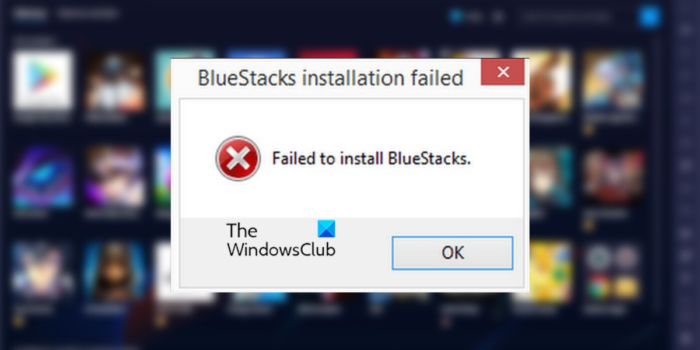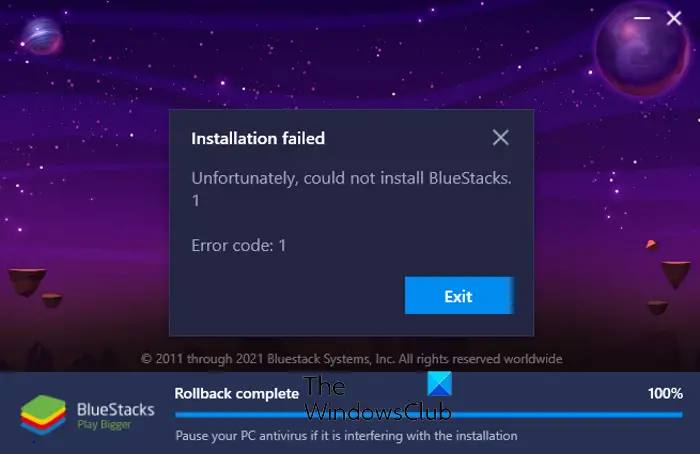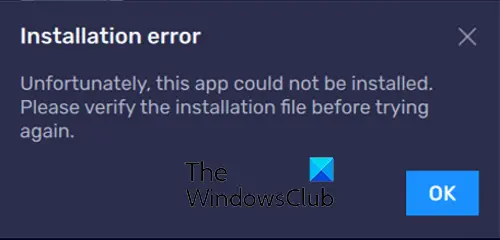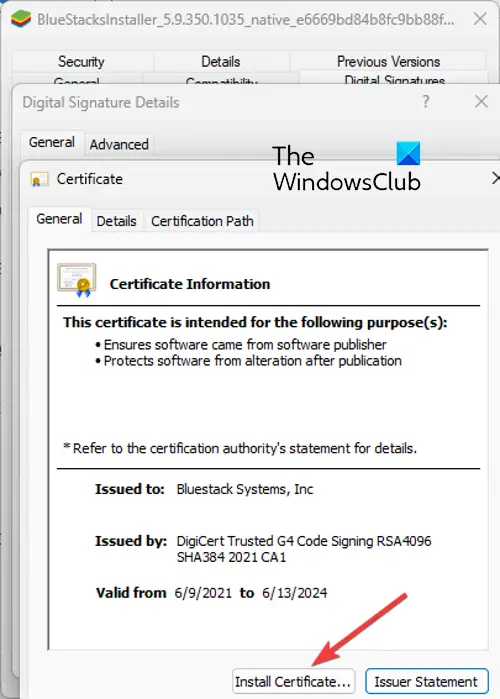Are you unable to install BlueStacks on your Windows PC? Several users have reported that the BlueStacks app just won’t install on their PC. They keep getting several installation errors when trying to install BlueStacks on their system. The error message varies for individuals. Sometimes, you get a simple “Failed to install BlueStacks” error prompt. While a lot of times, users get an elaborative error message with an error code.

Some users reportedly encounter the following error message:
Installation failed
Unfortunately, could not install BlueStacks.
1
Error code: 1

Other users have complained of getting the following error message when trying to run the BlueStacks installer:
Windows cannot access the specified device, path, or file. You may not have the appropriate permissions to access the item.
Some reported the below error message:
Installation error
Unfortunately, this app could not be installed. Please verify the installation file before trying again.

There can be several other error messages that you might encounter on the failed installation of BlueStacks. In any case, this guide will help you fix the issue and successfully install BlueStacks.
Why can’t I install BlueStacks?
Here are the potential causes that you are unable to install BlueStacks:
- Your PC doesn’t meet the minimum system requirements to run BlueStacks.
- If Hyper-V is enabled on your PC, BlueStacks might not install.
- Lack of administrator rights can also cause the same issue.
- An outdated graphics driver can be another reason why you can’t install BlueStacks.
- It can also be caused due to missing .NET Framework.
- An unstable internet connection might be one of the reasons for the issue at hand.
- Another reason for not being able to install BlueStacks can be antivirus interference.
There can be some other scenarios in which you can’t install BlueStacks. But, nonetheless, you can follow the fixes we have mentioned in this post and get rid of the issue.
Fix BlueStacks Failed to install
If BlueStacks fails to install on your computer, you can use the below fixes to resolve the issue at hand:
- Check the system requirements for BlueStacks.
- Update your graphics drivers.
- Run the setup file with admin privileges in compatibility mode.
- Turn off Hyper-V.
- Install .NET Framework.
- Make sure your internet connection is active and stable.
- Disable your antivirus.
- Install essential certificates.
- Completely uninstall BlueStacks’ previous version.
1] Check the system requirements for BlueStacks
Your computer needs to meet the system requirements for installing BlueStacks. The app will not install or work on your PC if it doesn’t meet the minimum system requirements. So, do check the system requirements for the android emulator and make sure that your computer fulfills them. Let us check out the minimum system requirement of BlueStacks.
- OS: Microsoft Windows 7 and above
- Processor: Intel or AMD Processor
- Graphics: Intel/Nvidia/ATI, Onboard or Discrete GPU with benchmark score >= 750
- RAM: 4GB or higher
- Storage: 5GB Free Disk Space
- Internet: Broadband network connection.
- Additional notes: You must be an administrator on your PC, Make sure Virtualization is enabled on your system.
If the above system requirements are fulfilled, there must be some other factors responsible for the failed installation of BlueStacks. So, move ahead and use the next potential fix to resolve the issue.
Read: Windows Subsystem for Android vs BlueStacks.
2] Update your graphics drivers
Having an up-to-date graphics driver is a minimum requirement to install and run BlueStacks on your computer. With an outdated graphics driver, you are likely to experience installation errors and other issues in BlueStacks. So, make sure you are using the latest version of your graphics driver. If not, update your graphics driver and then see if you can install BlueStacks or not.
Microsoft provides device driver updates as optional updates. You can download and install these updates directly from the Settings app. Here’s how to do that:
- Firstly, press the Windows + I shortcut key to open your Settings app.
- Now, go to the Windows Update tab and click on the Advanced options > Optional Updates option to check for device driver updates.
- After that, download and install the available graphics driver and other device driver updates.
- When the process is finished, restart your computer and run the BlueStacks installer to check if the app installs or not.
Device Manager can also be used for updating the graphics driver. You can also go to the official website of Intel, NVIDIA, or AMD as per the graphics card you own, and directly download the latest version of your graphics driver. Then, run the installer and install the latest graphics driver on your PC. There are also multiple free third-party driver updates that help you automatically install updates for your outdated graphics and other device drivers. You can try freeware like Winzip Driver Installer, IObit Driver Booster Free, etc.
If your graphics driver is up-to-date but BlueStacks is still not installing, use the next potential fix to resolve the issue.
3] Run the setup file with admin privileges in compatibility mode
The next thing you can do is run the setup file of BlueStacks as an administrator. You might be unable to install BlueStacks because of a lack of necessary permissions to run the installer. It is also mentioned by BlueStacks that administrator privileges are required to run the app. Hence, if the scenario is applicable, you can launch the installer with administrator rights and see if the problem is fixed. In addition to that, run the installer in compatibility mode. There might also be a compatibility issue which is why the app fails to install. So, this method will work for you.
Here are the steps to run BlueStacks’ installer as an administrator in compatibility mode:
- First of all, right-click on the setup file of Bluestacks and select the Properties from the context menu.
- Now, in the Properties window, move to the Compatibility tab and tick the checkbox called Run this program in compatibility mode for.
- Next, choose a previous version of Windows like Windows 8 or Windows 7 from the drop-down menu.
- After that, under the Settings section, checkmark the Run this program as an administrator option and press the Apply > OK button.
- Finally, run the BlueStacks installer and see if you can install the app without an error or issue.
If you still experience the same issue of being unable to install BlueStacks, move on to the next potential fix.
Read: How to uninstall a game or an app in Bluestacks?
4] Turn off Hyper-V
A lot of affected users have reported getting the following error message when the installation of BlueStacks fails:
The installation failed because Hyper-V is enabled. Please disable Hyper-V to complete installation.
You will face problems in installing or running BlueStacks if Hyper-V is enabled on your computer. So, if the scenario is applicable, disable Hyper-V and then try to install BlueStacks. You can follow the below steps to do that:
- Firstly, open the Command Prompt with administrator rights and type the below command:
bcdedit /set hypervisorlaunchtype off
- Now, press the Enter button and let the command execute.
- Finally, reboot your computer and then run the BlueStacks installer to see if the problem is resolved.
You can also disable Hyper-V in Windows using Control Panel, PowerShell, or Registry Editor.
If this scenario doesn’t apply to you, move on to the next potential solution to fix the problem.
See: BlueStacks cannot start when Hyper-V is enabled.
5] Install .NET Framework
In some instances, BlueStacks fails to install if .NET Framework is not installed on your system. Hence, if the scenario is applicable, install .NET Framework on your computer and then try installing BlueStacks. If the problem is fixed, well and good. However, if the issue continues, use the next potential fix to resolve the BlueStacks installation problem.
6] Make sure your internet connection is active and stable
Some components of BlueStacks require an active internet connection to install. If your internet connection is weak or unstable, the installation might fail. Hence, you need to ensure that there is no network connectivity issue and your internet is working fine. You can try using the below tips to fix network connectivity issues:
- Scan and fix WiFi issues on your computer.
- Restart your router or perform a power cycle on your router and then install BlueStacks.
You can also use BlueStacks offline installer if your internet is slow.
If your internet is not the problem, move on to the next potential fix to resolve the Installation error in BlueStacks.
See: BlueStacks keeps crashing or freezing on Windows PC.
7] Disable your antivirus
As per some reports, your third-party antivirus software like Avast, Bitdefender, Norton, Malwarebytes, etc. might interfere with the installation process of BlueStacks. Hence, if the scenario is applicable, you can fix the issue by disabling your antivirus to fix the issue.
If disabling the antivirus doesn’t work for you, consider uninstalling your antivirus software and then see if you are able to install BlueStacks or not. Launch the Settings app, go to Apps > Installed apps, and choose your antivirus app. After that, press the three-dot menu button and select the Uninstall option. Follow the onscreen instructions and once done, run the BlueStacks installer to check if the issue is resolved or not.
In case the BlueStacks app is still not installed successfully, try the next potential fix.
Read: Snapchat not working on BlueStacks Emulator on Windows 11/10.
8] Install essential certificates

You can try installing the required certificate for BlueStacks and then try installing the app. Here’s how to do that:
- Firstly, right-click on the BlueStacks installer and select the Properties option.
- Now, go to the Digital Signatures tab, select the signature, and click on the Details button.
- Next, click on the View Certificate button and then press the Install Certificate button.
- After that, choose Current User and tap on Next.
- Now, click on the Automatically select the certificate store based on the type of certificate option and press Next.
- Finally, click on Finish and when the certificate is installed, try installing BlueStacks.
If the problem remains the same, we have one more fix that you can use to resolve the issue at hand.
Read: BlueStacks is stuck on Starting the Engine screen.
9] Completely uninstall BlueStacks’ previous version
If you are trying to install a newer version of BlueStacks when you already have a previous version installed, uninstall the previous version completely. After uninstalling it, try installing the newer version and see if the problem is fixed or not. The previous version might be conflicting with the newer one and causing issues in its installation. If that is the case, this method will work for you.
You can uninstall BlueStacks completely via the Settings app. Open Settings, click on Apps > Installed app, select BlueStacks, click on the three-dot menu option, and select the Uninstall option. Once done uninstalling the app, make sure to delete all the remnant files from your PC. For that, follow the below steps:
- Firstly, press the WIn+E hotkey to open File Explorer and go to the C:\ProgramData folder.
- Now, delete the BluestacksSetup folder in the above location.
- Next, hit WIN+R to open Run, enter %temp% in it, and delete all the folders.
- After that, open Registry Editor and go to the following location:
HKEY_LOCAL_MACHINE\SOFTWARE\BlueStacks
- Then, delete the BlueStacks keys and values associated with BlueStacks from the left pane.
- Once done, reboot your computer and then try installing BlueStacks.
Hopefully, you will now be able to install BlueStacks without any problem.
See: BlueStacks stuck on Initializing screen on Windows 11/10.
How do I fix BlueStacks app installation error?
If BlueStacks is not working or opening on your Windows PC, it could be due to out-of-date graphics drivers. The problem might also be caused due to interference from your antivirus. Third-party software conflicts can also trigger the same issue. In a lot of cases, a corrupted installation of BlueStacks can be one of the reasons why it is not working properly.
Can Windows 11 run BlueStacks 5?
Yes, BlueStacks runs on Windows 11 as the minimum system requirement to run it is Windows 7. You can easily download and install BlueStacks and then open and run android apps and games on your Windows PC.
Hope this post helps you fix the installation errors in BlueStacks.
Leave a Reply